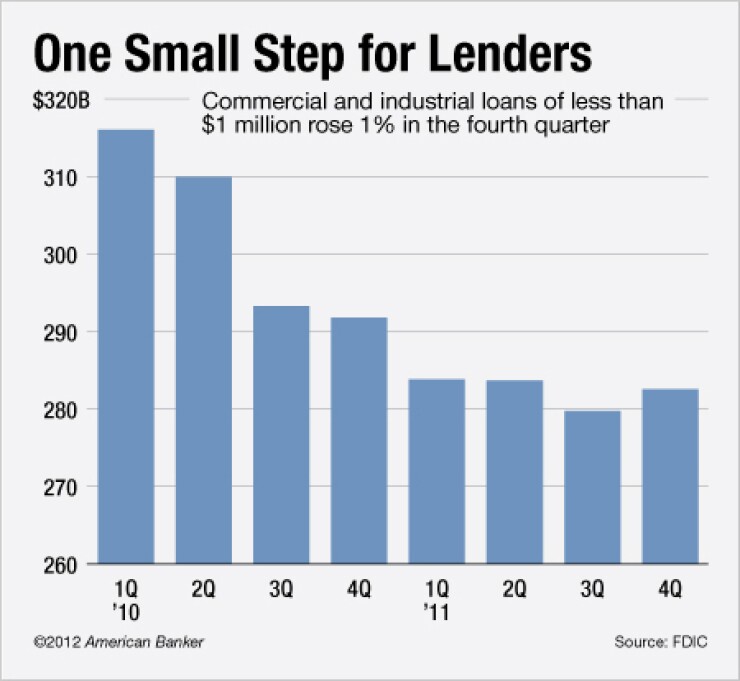-
Banks are clamoring to lend to the most creditworthy small businesses, even as credit availability remains broadly limited.
April 18 -
Bank of America (BAC) has hired more than 90 small-business lenders in the Southeast as part of a broader push to add 1,000 relationship bankers throughout the country by the middle of the year.
April 3

Don't reinvent the wheel.
That is the crucial piece of advice from lenders in the heated race for the
Executives at HSBC, BB&T (BBT), Bank of America (BAC) and Regions Financial (RF) are certainly trying many different things: focusing on international business and other niches, streamlining decision-making, hiring bankers and redoubling efforts to retain clients.
But each bank is trying to build off expertise it already possesses.
"It's very important that a bank really think about what they want to do well and really understand what their strengths are," Mark Luppi, the head of business banking at HSBC Bank USA, told American Banker in an interview at a small-business lending conference in April.
HSBC is trying to extend its specialty in international banking to smaller firms that fit the right profile.
"We look at prospects that are currently doing international business, or we think have the potential to do it, and we are proactively reaching out to those businesses," Luppi says. "Up to 40% of small businesses in the U.S. are moving into the international market. … It's a growing population," he says.
These businesses typically produce annual revenue between $3 million and $50 million, according to Luppi.
HSBC has also developed a website called businesswithoutborders.com to attract potential borrowers thinking about expanding overseas. "It creates a very efficient way to get the process moving," Luppi says.
BB&T is trying to streamline its entire approach to small-business lending, J. Tol Broome Jr., its chief commercial credit officer, told American Banker in an interview at the conference.
"What we're really trying to focus on is to simplify our process, to make it easier for our clients and our associates to get loans done on the small end and to provide more support to make sure that we are as reliable and responsive as we can be," he says of the effort, which began last summer.
The bank's C&I lending grew at an annual rate of 11% in the fourth quarter from the third quarter, he says, adding "that was a pretty good quarter for us, and certainly some of that came in the small end of the portfolio."
C&I loans grew 9% in the first quarter of 2012, BB&T
He cautions that the revamped approach is not about cutting corners but demanding only the most essential documentation.
"It's just kind of focusing on the 'gotta-have' things to make loan decisions, and not necessarily building a 6-inch thick credit file on a $300,000 loan. You can still make really good decisions with enough information, but not put the client through quite so much as if they were borrowing $20 million," Broome says.
Meanwhile, Bank of America has hired about 800 of a planned 1,000 additional bankers dedicated to small-business services, B of A's small business executive Robb Hilson told American Banker in an interview on Thursday.
"There's certainly an opportunity for us to get double-digit revenue growth from this business," Hilson says.
He says the
"A good chunk of their time is devoted to deepening relationships," Hilson says.
Small-business owners "say they want advice. Generally they're not talking about growing to the point where you can take them public. They're saying, 'I'm thinking about buying from a supplier overseas,' or … 'Can you talk about the benefit of buying in a foreign currency?' or … 'Tell me about check fraud,'" he says.
But at the same time, bringing in new prospects still remains a priority.
"Every one of them [the bankers] is challenged to have circles of influence … and to spend time at their local chambers of commerce," he adds.
David Tremblay, B of A's client development group executive, told American Banker in an interview earlier this month that the bank has been able to make important inroads by using less conventional forms of communication.
The program was developed when B of A bought FleetBoston Financial in 2004. Back then, bankers were skeptical of using the phone and e-mail to stay in contact with small business borrowers, according to Tremblay.
"Nobody believed a business client would buy over the phone back then," he says.
But "people vote with their feet, and our attrition rate has gone way down over the years," Tremblay adds. "And frankly I think clients realize e-mail is an effective way of communicating, and the phone is good. There's not as much golfing and big dinners that goes on."
B of A's client development group for small businesses, which handles borrowers with more complex lending needs, now has revenue growth in the low single digits, according to Tremblay. That compares with a shrinkage in double digits in 2004, he says.
Hilson, the bank's small-business head, adds that B of A is also maintaining a focus on lending to doctors, veterinarians and other types of professional practice groups.
That piece of the business has been growing more than 20% annually for the last several years, according to Hilson.
"We understand how these industries work, and how these practices work," he says.
Other banks are taking an industry-specific approach to finding new small-business lending prospects.
Regions is also focusing much of its attention on select industries, Lynetta Steed, head of business and community banking at Regions, told American Banker at an interview earlier this month at the small-business lending conference.
"It's a very targeted approach," says Steed, who points to women-owned business, franchise restaurants, agriculture, health care and Small Business Administration loans as the "key five" areas the bank currently targets.
"The whole point of that is so that if I have a branch manager or a business banker and they want to become the face of a franchise lender, or they want to be known in the market, then what we've done in the corporate office is we have set up all the infrastructure … all the documentation, all the underwriting. We've already worked with our credit partners on policy, so that they don't have to reinvent the wheel every time they come back," she adds.





